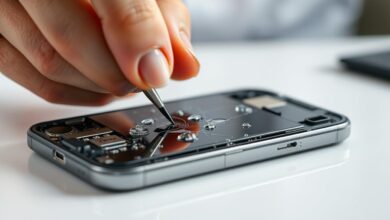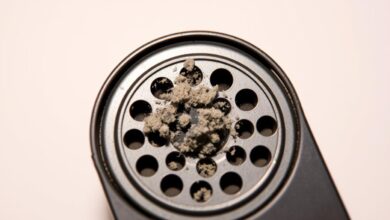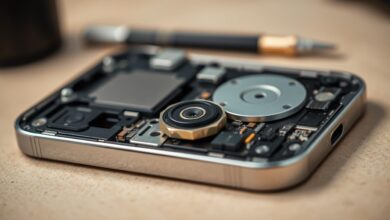how do you get water out of your phone
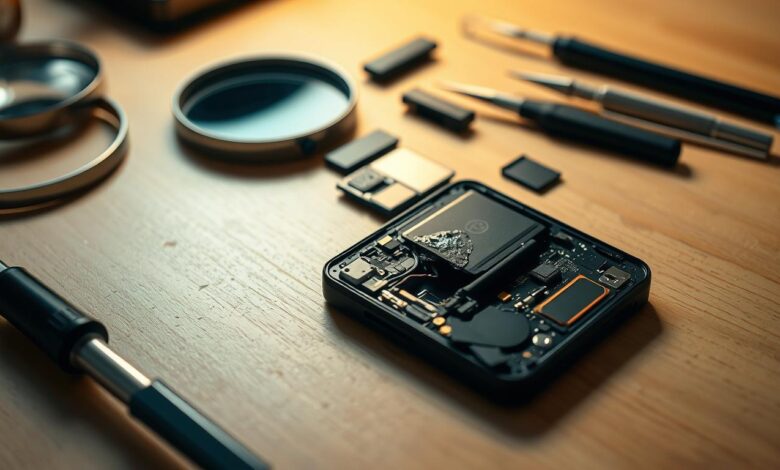
Getting your phone wet can really mess it up. It’s important to know how bad it is and act fast to fix it.
I’ll show you how to save your phone step by step. First, you need to act quickly. Water and phones don’t mix well. If you don’t fix it fast, it might not work again.
Fixing a water-damaged phone is a common problem. But, if you do the right things, you might get your phone working again.
Key Takeaways
- Act quickly to minimize water damage.
- Avoid using heat to dry your phone.
- Turn off your phone immediately.
- Remove accessories and SIM cards.
- Dry your phone with desiccants or silica gel packets.
Understanding Phone Water Damage
Water damage to a phone can be very costly. It can lead to expensive repairs or even needing a new phone. When a phone gets wet, it can suffer from different types of damage.
Types of Water Damage to Phones
Water damage can include corrosion, short circuits, and component failure. Corrosion happens when water reacts with the phone’s parts, causing them to break down. Short circuits occur when water creates a path for electricity, damaging the phone’s circuitry.
For more information on what to do after spilling liquid on your device, you can visit this resource for guidance.
How Water Affects Phone Components
Water can harm many phone parts, like the circuit board, battery, and screen. When water gets in, it can corrode the circuit board, causing faulty connections. The battery might malfunction or swell. Water can also damage the screen, leading to display problems or unresponsiveness.
The Critical Timeline for Water Damage
The sooner you act, the less damage your phone will suffer. The first few minutes are crucial. By understanding the damage water can cause, you can take quick action to save your phone.
Immediate Actions When Your Phone Gets Wet
When your phone gets wet, quick action is key. The sooner you act, the less damage your phone will suffer. Water can cause corrosion and harm your phone’s parts if it stays for too long.
Power Off Immediately
The first thing to do is power off your phone right away. This stops short circuits that could damage it more. Even if your phone looks okay, turning it off is crucial to avoid electrical problems.
Remove Accessories and External Components
Then, take off any accessories like phone cases, SIM cards, and memory cards. This reduces moisture trapped against your phone. Removing these parts also lets you check for water in hidden areas.
Wipe External Moisture
Use a soft cloth to wipe your phone’s outside and remove moisture. Don’t press too hard, as this could push water inside. Your goal is to get rid of as much moisture as you can.
Remove SIM Card and Memory Card
Removing the SIM card and memory card helps dry your phone and keeps your data safe. Water damage might not reach these cards, so taking them out protects your data. This way, even if your phone can’t be fixed, your contacts and data will be okay.
Experts say, “The key to saving a wet phone is quick and effective action.” By acting fast and following these steps, you can greatly improve your phone’s chances of being fixed and working again.
What NOT to Do with a Water-Damaged Phone
When your phone gets wet, knowing what not to do is key. The right actions right away can help your phone recover. Here, I’ll share common mistakes and myths to avoid with a water-damaged phone.
Common Mistakes That Worsen Damage
One big mistake is panicking and doing things that harm your phone. For example, shaking or blowing into it can push water deeper. Also, using heat to dry it can damage the circuitry.
Let’s look at some common mistakes and their effects:
| Mistake | Consequence |
|---|---|
| Shaking or blowing into the phone | Pushes water further into internal components |
| Using heat sources to dry the phone | Causes damage to internal circuitry |
| Turning on the phone immediately | Can cause short circuits and further damage |
Myths About Drying Phones
There are many myths about drying a wet phone. One is using a hair dryer or oven to dry it fast. But, this can actually harm it. Another myth is that rice can absorb all moisture. While rice helps, it’s not a perfect solution.
Why Turning On a Wet Phone Is Dangerous
Turning on a wet phone can lead to short circuits and more damage. The electrical current can flow through the water, causing corrosion. It’s best to keep your phone off until it’s dry.
Avoid Using Heat Sources
Heat from a hair dryer or oven can damage your phone’s parts. It can warp or melt the circuitry, making repairs hard or impossible. Instead, use desiccants or let it dry naturally.
Avoiding these mistakes and myths can help you fix your water-damaged phone and do a successful phone water extraction.
How Do You Get Water Out of Your Phone: Step-by-Step Methods
If you’ve dropped your phone in water, it’s important to dry it right to avoid damage. You need to act fast and use the right methods. Here, I’ll show you four ways to dry your phone: using gravity, gentle tapping, compressed air, and isopropyl alcohol.
Gravity Method: Positioning Your Phone
The gravity method is simple to start drying your phone. Turn it off and place it so gravity helps remove water. Hold it with the charging port down. This helps water drain out.
As Apple Support says, “the first step is to get the water out of the device.” Gravity can help a lot in this process.
Gentle Tapping Technique
After using gravity, gently tap your phone to remove water from ports. Don’t tap too hard to avoid pushing water in. A soft tap can help get water out of the charging port and speakers.
A study found that gentle tapping works well for removing water from phone speakers.
Using Compressed Air Safely
Compressed air can dry your phone, but safely. Hold the can upright and spray short bursts from 6 inches away. Aim for ports and crevices where water gathers.
As PCMag suggests, “use compressed air to gently blow out moisture.” But, don’t spray too close to avoid damaging parts.
Isopropyl Alcohol Cleaning Method
Isopropyl alcohol is good for cleaning ports and slots. Dip a cotton swab in alcohol and clean gently. It dissolves water residue.
“Isopropyl alcohol is a common cleaning agent for electronics because it evaporates quickly and doesn’t leave residue,”
an electronics repair expert says. Let parts dry completely before putting them back or turning on your phone.
By following these steps, you can dry your phone well. Remember, act fast and be gentle to avoid more damage.
The Rice Method: Does It Really Work?
Many people wonder if using rice to dry a wet phone works. The idea is popular, but its success is debated.
Science Behind the Rice Method
The rice method relies on rice absorbing moisture. But, getting moisture out of a phone’s tiny parts is hard.
Proper Rice Drying Technique
To dry your phone with rice, fully submerge it in rice. Seal it and wait 48 hours without shaking it.
Limitations and Potential Issues
Rice can remove moisture, but it has downsides. Rice dust and starch might harm your phone. It also might not work for all water damage.
Expert Opinions on the Rice Method
Experts have different opinions on rice for drying phones. Some see it as a temporary fix, while others think it’s risky. Here’s a comparison of drying methods:
| Drying Method | Effectiveness | Potential Risks |
|---|---|---|
| Rice Method | Moderate | Rice dust damage |
| Silica Gel | High | None significant |
| Compressed Air | Low | Potential for pushing debris further in |
In summary, rice can help dry a wet phone, but it’s not perfect. Looking into other methods might be better for fixing water damage.
Effective Alternatives to Rice for Drying Phones
Drying a wet phone doesn’t need rice. Many other methods work well. Rice is messy and not always effective. Luckily, there are better ways to dry your phone.
Silica Gel Packets
Silica gel packets are great for drying phones. They soak up moisture and are found in electronics packaging. Put your phone in a container with these packets and seal it. They’ll dry your phone out.
Commercial Desiccants
Commercial desiccants are another choice. They’re made to absorb moisture better than rice. They come in bags and containers and can be reused. Always follow the instructions for the best results.

Uncooked Oatmeal and Cat Litter Options
Uncooked oatmeal and cat litter can also dry a wet phone. They absorb moisture but might not work as well as silica gel or commercial desiccants. Place your phone in a container and cover it with the material. Be careful, as they can be messy and leave residue.
Comparing Absorption Rates of Different Materials
Silica gel packets absorb moisture better than rice and other options. Commercial desiccants are also effective, depending on their type. Oatmeal and cat litter are less efficient but can still help. Choose a method based on the material’s absorption rate and convenience.
In conclusion, there are many alternatives to rice for drying wet phones. Each has its own benefits. By picking the right desiccant, you can dry your phone and possibly save it from water damage.
Using Drying Agents and Absorbent Materials
Drying agents and absorbent materials are key in drying a wet phone. When your phone gets wet, removing moisture is crucial. This is where drying agents play a big role.
How Desiccants Work
Desiccants absorb moisture from their surroundings. They create a dry space that helps moisture leave the phone’s parts. Desiccants like silica gel packets are great for drying wet phones.
Creating a DIY Drying Kit
You can make a DIY drying kit with simple items. Use silica gel packets or uncooked rice in a sealed container. Put your phone in it, cover it with the desiccant, and seal it. This setup helps pull moisture out of the phone.
Optimal Drying Time with Different Materials
The drying time varies with the material. Silica gel packets dry phones faster than uncooked rice. It’s best to leave your phone in the drying material for at least 48 hours for thorough drying.
Combining Methods for Better Results
Combining drying methods can give better results. For example, using silica gel packets with a gentle warm environment can help. Be patient and don’t rush the drying process to avoid damage to your phone.
Professional Water Extraction Tools and Kits
Professional tools and kits are key for fixing water-damaged phones. DIY methods often can’t handle the damage. Specialized equipment boosts the chance of fixing a phone.
Commercial Water Damage Recovery Products
Many commercial products help fix water-damaged phones. These range from simple drying kits to complex systems. Brands like Water Damage Recovery and Phone Rescue offer kits with desiccants and drying agents.
Vacuum Chamber Technology
Vacuum chamber technology is advanced for drying phones. It creates a vacuum to pull out moisture. This method is safe and effective for fixing water-damaged phones.
Professional-Grade Drying Equipment
Professional drying equipment dries phones fast and well. It uses heat, air flow, and vacuum. These machines are great for phones soaked in water for a long time.
Cost-Benefit Analysis of Professional Tools
Professional tools and kits cost more than DIY methods. But, they have a higher success rate. For those who need their phones, the investment is worth it to get their device fixed.
Removing Water from Specific Phone Components
When your phone gets wet, it’s not just the outside that’s at risk. Water can sneak into many parts inside, causing harm. Knowing how to dry these areas is key to saving your phone.
Cleaning Water from Charging Ports
The charging port is very sensitive to water. Start by tilting your phone to let gravity help drain the water. Be careful not to use sharp objects that could hurt the port’s tiny pins.
Compressed air can help, but use it carefully. Hold the can upright and spray short bursts into the port to avoid pushing water in.
Addressing Speaker and Microphone Moisture
Water in the speaker or microphone can mess up sound. Gently tap the area against a soft surface with the phone down to help water come out.
To dry it better, use desiccant packets or uncooked rice. Place your phone in a container with these to soak up the water.
Dealing with Water Under the Screen
Water under the screen can cause touch issues or water spots. Let the phone air dry or use a desiccant. If damage is severe, you might need a pro to fix it.
Battery Compartment Water Removal
If your phone’s battery comes out, remove it and dry both. Use a soft cloth or cotton swab to wipe away moisture. For non-removable batteries, be careful not to use too much force or liquids that could harm the inside.
Here’s a quick guide on how to remove water from different parts of your phone:
| Component | Method 1 | Method 2 |
|---|---|---|
| Charging Port | Gentle Tapping | Compressed Air |
| Speaker/Microphone | Tapping | Desiccant Packets |
| Under Screen | Air Dry | Desiccant |
| Battery Compartment | Soft Cloth | Cotton Swab |

Model-Specific Water Removal Techniques
Knowing how to remove water from your phone is key to fixing it. Each phone model is different, which means different fixes. We’ll look at how to recover from water damage for each model.
iPhone Water Damage Recovery
If your iPhone gets wet, act fast. Apple phones have special designs that affect how to fix them. First, dry the outside gently and avoid heat. Then, use desiccants or silica gel to soak up moisture.
Samsung Galaxy Water Extraction Methods
Samsung Galaxy phones need careful handling when wet. Try using gravity and gentle tapping to remove water from ports. Also, compressed air can help, but be careful not to push water in.
Google Pixel Water Damage Solutions
Google Pixel phones are sleek and water-resistant but still need quick action. Turn it off and remove accessories first. Clean corrosion with isopropyl alcohol, but make sure it’s dry before charging.
Other Android Phones Water Removal Tips
Other Android phones follow similar steps, but the exact method depends on the model. Desiccants, silica gel, or uncooked oatmeal can absorb moisture. Always avoid heat to prevent more damage.
For any phone, quick action and the right method are crucial. Knowing your phone’s specific needs can help fix it successfully.
Different Water Types and Their Impact on Phones
Water can harm your phone in different ways, depending on its type. Knowing the differences is key to fixing the damage.
Freshwater vs. Saltwater Damage
Freshwater is less harmful than saltwater because it’s less corrosive. But, both can still damage your phone’s parts. Saltwater, with its high salt, can corrode faster and harm circuitry.
Chlorinated Pool Water Effects
Chlorinated pool water is especially bad because of its chemicals. Chlorine can corrode metal and harm circuitry. If your phone got wet in a pool, rinse it with fresh water and dry it well.
Handling Soda, Coffee, and Other Liquid Spills
Liquids like soda and coffee can also cause damage. Their sugar and acidity can corrode parts. For tips on dealing with spills, check wikihow’s guide on saving a wet cell.
Toilet Water Contamination Concerns
Toilet water is full of bacteria and harmful stuff. It can corrode and cause short circuits. Clean your phone right away to avoid more damage.
In summary, the type of liquid matters a lot. Knowing what hit your phone can help you fix it.
Assessing Phone Damage and Salvageability
Checking your phone for water damage is key to knowing if it can be fixed. Water damage can show up in many ways. Knowing how bad it is helps decide if you should fix or replace your phone.
Signs Your Phone Might Be Permanently Damaged
There are signs your phone might be damaged for good. These include:
- Corrosion on the internal components
- Failure to turn on or boot up
- Screen discoloration or display issues
- Speaker or microphone malfunction
- Charging port damage
“If your phone shows any of these signs, the damage is likely severe.”
Testing Functionality After Drying
After drying your phone, test if it works. First, try turning it on and see if it acts strangely. Check the touchscreen, speakers, microphone, and camera to make sure they work right.
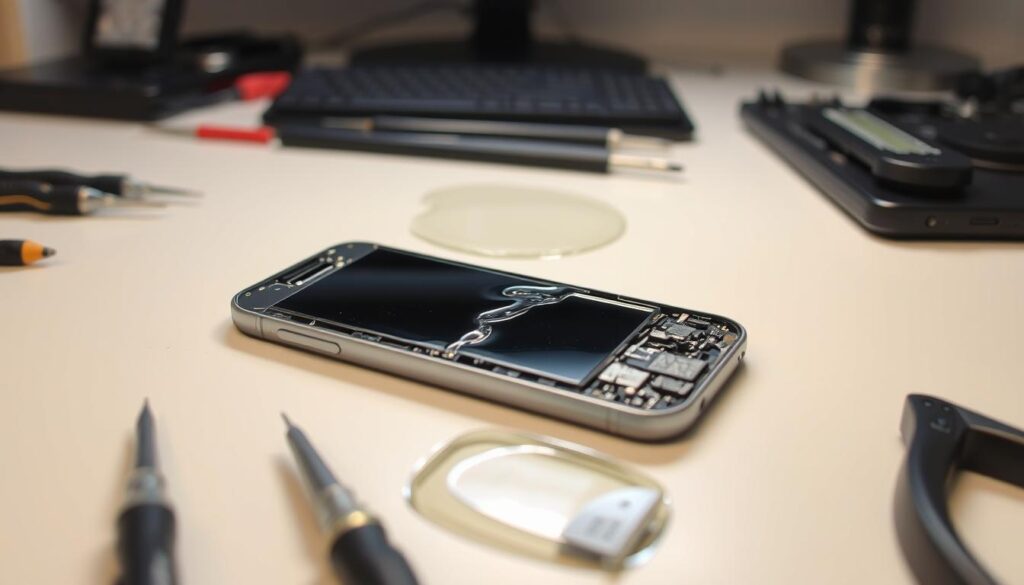
When to Consider Replacement
If your phone is old, fixing it might not be worth it. Also, if the damage is too much or the fix is too expensive, getting a new one might be better.
Remember, “sometimes it’s better to let go and move on.”
Data Recovery Options for Water-Damaged Phones
Even if your phone won’t turn on, you might still get your data back. Professional services can often get data from damaged phones. It’s important to act fast and not turn on the phone to avoid more damage.
According to a data recovery expert,
“The key to successful data recovery is to minimize further damage by not powering on the device and seeking professional help immediately.”
When to Seek Professional Repair Services
If your phone still has water damage after trying DIY fixes, it’s time to get professional help. DIY methods work for small water issues. But, serious damage needs special tools and skills.
Signs DIY Methods Aren’t Working
DIY fixes might not work if your phone still has problems. This includes a broken screen, not working buttons, or ongoing water damage. If you see these signs, you need a pro.
Common issues that persist after DIY attempts include:
- Corrosion damage to internal components
- Water still present in the phone’s charging port or other areas
- Malfunctioning speakers or microphones
What Professional Repair Technicians Can Do
Professional repair techs can fix complex water damage. They use special tools and know-how to:
- Remove water with advanced techniques
- Repair or replace damaged parts
- Get rid of corrosion
A repair expert says, “Professional services can really help if DIY fails.”
Cost Considerations for Professional Repair
How much professional repair costs depends on the damage, phone type, and service. Prices range from $50 to over $200. Always ask for a quote first.
Finding Reputable Water Damage Repair Services
To find a good repair service, look for:
- Good customer reviews and ratings
- Experience in water damage repair
- A warranty or guarantee
Choosing a trusted service means your phone is in safe hands. It also boosts the repair success rate.
Preventing Future Water Damage to Your Phone
There are many ways to keep your phone safe from water damage. Using the right accessories and being careful can help a lot. This way, you can avoid accidents that might harm your phone.
Protective Cases and Covers
Using a protective case or cover is a smart move. These items act as a shield between your phone and water. This can greatly lower the chance of damage. Look for cases that are made to be waterproof or water-resistant.
- Waterproof Cases: These cases keep your phone dry even when it’s underwater.
- Water-Resistant Cases: Not fully waterproof, but they can protect your phone from splashes or rain.
Waterproofing Sprays and Treatments
Waterproofing sprays or treatments are another option. They create a layer on your phone that repels water. This helps keep your phone’s inside parts safe.
It’s crucial to follow the instructions from the maker when using these treatments. This ensures they work well.
Habits to Reduce Water Exposure Risk
Changing your daily habits can also help. For instance, being more careful with your phone near water can help a lot.
- Keep your phone away from water sources like sinks, bathtubs, and pools.
- Avoid using your phone in humid places, like steamy bathrooms.
Water Detection Apps and Accessories
Some phones and accessories have water detection features or apps. These alert you if your phone might be exposed to water. They can help spot risks early on.
By using these preventive steps, you can greatly lower the risk of water damage to your phone. This keeps your phone working well and reliable.
Conclusion
Getting your phone out of water damage needs quick action and the right steps. Knowing the type of water damage and acting fast, like turning off your phone and removing accessories, can help a lot. This can improve your phone’s chances of being fixed.
Using silica gel packets or isopropyl alcohol can dry out your phone. For serious cases, getting professional help is a good idea. For more tips on fixing water-damaged phones, check out this resource.
Being ready and taking steps to prevent water damage can keep your phone safe. Knowing how to handle water and taking action early can reduce damage risks. This way, your phone stays in good shape.
FAQ
How do I know if my phone has water damage?
Look for corrosion, water spots on the screen, or a phone that won’t start. Most phones have a Liquid Contact Indicator (LCI) that changes color when wet.
Can I use a hair dryer to dry my water-damaged phone?
No, using a hair dryer or heat can harm your phone’s parts. Instead, use desiccants or other drying methods.
How long should I leave my phone in rice to dry?
The rice method is debated. If you use it, leave your phone in rice for 48 to 72 hours. But, silica gel packets or commercial desiccants might work better.
Can saltwater damage my phone more than freshwater?
Yes, saltwater is more corrosive and can damage your phone’s parts more. Rinse your phone with freshwater if it’s in saltwater, then dry it right away.
Is it safe to turn on my phone after it’s been submerged in water?
No, turning on a wet phone can cause a short circuit. This can lead to more damage. Keep your phone off until it’s dry.
How can I remove water from my phone’s charging port?
Gently tap your phone to remove excess water. Then, use a soft cloth or cotton swab to dry the port. Avoid sharp objects that could damage it.
Can I repair water damage on my iPhone myself?
You can try drying and cleaning yourself. But, complex repairs might need a pro, especially for newer iPhone models.
What are the best methods to dry out a wet phone?
Good methods include silica gel packets, commercial desiccants, or the gravity method. Avoid rice or heat sources.
How can I prevent water damage to my phone in the future?
Use a protective case and consider waterproofing sprays or treatments. Be careful with your phone’s water exposure. Water detection apps can also warn you of moisture.
Can water damage cause data loss on my phone?
Yes, water damage can cause data loss. If your phone is still working, try to recover your data quickly. If not, get professional help.
Are there any phone models more resistant to water damage?
Some phones, like those with IP68 ratings, are more water-resistant. But, no phone is completely waterproof. Water resistance can also decrease over time.
